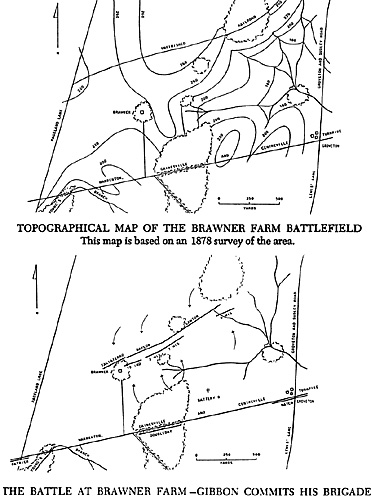Reproducing the scenario can be a problem depending on what one wishes to accomplish. If you fight the battle in an historical manner, using just the troops that were actually involved, the Confederates will likely win without giving the Union force some sort of edge. The Stonewall Brigade would have to be considered Elite troops. The Iron Brigade at this time had little or no combat experience but performed like Elite status soldiers. I recommend that they be made "Elite", along with all Union artillery batteries, and that the remaining Union troops be made "Veteran". Also, Confederate forces other than the Stonewall Brigade should be made Veteran. By doing this, the odds are somewhat evened out. An additional necessity is to regard all Union troops as being behind hasty works. This can be rationalized by the difference in the fences that the two sides sheltered behind. Diaries and letters of Confederates when fought at Brawner Farm state that the wooden fence they used as shelter was "so dry that it splintered with every ball".
The battle of Brawner Farm was a short-lived engagement due to the fact that it started at about 6:30 p.m., and darkness forced a conclusion to the fighting by 9:30. I believe that visibility should be steadily reduced from 7 p.m. to 8:30 p.m., by which time actual sight was limited to no more than 40 yards (1 inch in the JOHNNY REB rules). A further adjustment for the scenario should be that Gibbon adds a "plus 2" to any regiment that he is attached to, while all Confederate commanders should add a +1. This is to compensate for the casualties in brigade commanders for the rebels. If a Confederate brigade or division leader is hit, the replacement figure will have no effect. Doubleday should add a +1 for any regiment he is attached to.
The scenario lasts 12 turns. Beginning with the 4th turn, visibility should be reduced to 6 inches, and beginning the 10th turn, should be limited to one inch. Troops may shoot at targets further away than this, but such should be considered "AREA FIRE", reducing factors by 1/2.
A Union victory would be defined as Federal forces still in good order are holding Brawner Farm by game's end. A Confederate victory would be gained by pushing all Union troops south of the Turnpike. Anything less than these two conditions would be considered a draw.
DEPLOYMENT AND ORDERS OF BATTLE
The game should begin at 6:30 p.m. with the 2nd Wisconsin and 19th Indiana in line of battle as shown in the first map. At 6:45 (turn 2) the Stonewall Brigade would advance up to 6 inches away. From this point on it must be up to the participants of the game as to when reinforcements should arrive, in what order they arrive, and where they should be placed. To structure the scenario more than this would be to take it out of the hands of the gamers. A look at the maps will give you clues as to how best to deploy.
The units listed in this order of battle are only those who actually participated in the engagement. In many cases, actual numbers are not known. When possible, regimental strengths have been included. I advise that the small regiments of the Confederate Army be combined in groups in order to have reasonably playable units. I have taken the liberty of doing this in the OB. In some cases, a brigade may end up only consisting of one "unit".
UNION FORCE: Commanded by Genl. Rufus King (absent during battle)
Gibbon's Brigade (Iron Brigade): Brigadier General John Gibbon (+2)
- 19th Indiana = 423 men
2nd Wisconsin = 430
6th Wisconsin = 504
7th Wisconsin = 580
Doubleday's Brigade: Brigadier General Abner Doubleday (+1)
- 56th Pennsylvania = 300
76th New York = 250
95th New York = 300
Artillery:
- Battery "B", 4th U.S. Artillery = 6 Napoleons
Battery "D", Ist Rhode Island Lt. Artillery = 6 ten lb. Parrots
Battery "L", Ist NY Lt. Artillery = 6 ten lb. Parrots
CONFEDERATE FORCE: Commanded by Stonewall Jackson (may not be attached to units)
Jackson's Division: Brig. Genl. William B. Taliaferro (+1)
1st Brigade (Stonewall): Col. William Baylor (+1)
- 2nd and 4th Virginia = 350
5th, 27th, and 33rd Virginia = 525
3rd Brigade: Col. Alexander Taliaferro (+1)
- 47th and 48th Alabama (did not fight)
10th, 23rd, 37th Virginia = 600
Ewell's Division: Major Genl. Richard Ewell (+1)
Lawton's Brigade: Brig. Genl. Alexander Lawton (+1);
- 13th and 26th GA. = 400
31st and 38th GA. = 400
60th and 61 st GA. = 300
Trimble's Brigade: Brig. Genl. Isaac Trimble (+1)
- 15th Alabama and 21st North Carolina = 400
12th & 21st Georgia 400
Artillery:
- Alleghany Battery = 2 Napoleons, 2 three inch rifles
Danville Battery = two 6 lb. smoothbores, one 3 in. rifle, one 10 lb. Parrot
Rockbridge Artillery = one Napoleon, one 6 lb. smoothbore, two 10 lb. Parrots
Stuart Horse Artillery = two 3 inch rifles
Map
Contours represent 20 feet, from 180 feet adjacent to the stream to 260 feet at the Unfinished RR line.

Battle of Brawner Farm: Prelude to 2nd Manassas
Battle of Brawner Farm: The Iron Brigade Goes into Battle
Back to The Zouave Vol I No. 5 Table of Contents
Back to The Zouave List of Issues
Back to Master Magazine List
© Copyright 1987 The American Civil War Society
This article appears in MagWeb (Magazine Web) on the Internet World Wide Web.
Other military history articles and gaming articles are available at http://www.magweb.com